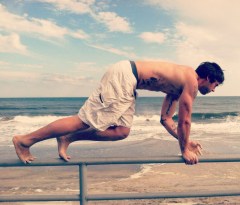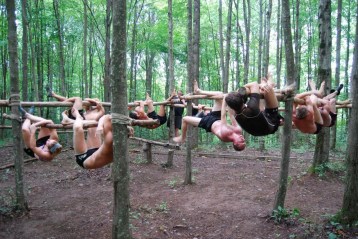Everything old becomes new again, so it was just a matter of time before the next big thing in fitness turned out to be climbing and running and jumping — you know, the things you used to do as a kid and before you knew it was exercise.
It’s a new year, which means gyms are brimming with people working up a sweat to fulfill New Year’s resolutions. But for some, a gym full of blaring music and treadmills is the last place they go to get fit.
Except now it’s called “natural movement,” and, as it was when you were young, there’s no gym necessary. Instead of eeking out sets of pull ups or pumping free weights, you shimmy up trees and hurl boulders. It’s probably the oldest way to workout, but somehow it’s fallen out of favor.
That’s why MovNat fans are hoping to bring it back, and along with it, a more practical perspective on why we should be fit. Devotees bill it as a paleo-fitness, functional movement system and followers believe being “beach ready” doesn’t mean washboard abs, but rather being capable of rolling, crawling and sprinting across the sand–possibly to dive into raging waters to save a struggling swimmer. Seriously.
(VIDEO: We Tried This: Aerial Vinyasa (or Upside-Down) Yoga)
“This isn’t about the elite fitness of winning gold medals. It is about doing the movements that make us humans, and acquiring a physical competence that we can maintain for a lifetime,” says Erwan Le Corre, who created MovNat in 2008.
MovNat is a fitness system based on natural human movement and builds upon the basic activities we engaged in as kids while we played: running, crawling, jumping, lifting and catching. It’s influenced by some of the earliest fitness training methods like Georges Hebert’s “Methode Naturelle,” which relied on using natural “props” like trees and hills to improve strength and agility. Urban jungles, MovNat fans argue, don’t count. In fact, living indoors has interfered with our ability to move as effortlessly and naturally as we used to in navigating natural environments.
“Why do you move in the first place?” says Le Corre. “It’s not about how you look, or how much you can bench press. It’s [about] being able to perform practical movements in day-to-day life or in unexpected and even sometimes dangerous situations.” Le Corre is a 41 year-old Frenchman who has been called “one of the fittest men in the world” and finds the idea of gyms ludicrous. Instead, he prefers lifting heavy logs, climbing trees and leaping from rocks.
(MORE: We Tried This: Fast And Furious Tabata)
Since starting MovNat, he’s gained a robust following and hosts training retreats around the world from Spain to Singapore. He’s also certified a battalion of trainers worldwide to spread the movement, including Brandon Sewall, a wellness coach in New York City who runs his own training program called Primitive Movement that shares Le Corre’s principles. Sewall led me through a beginner training session in the decidedly unnatural environment of Manhattan.
“Doing this feels good, and your body wants to do it. You have to. It’s vital and instinctual. It makes you feel that much better, stronger, coordinated and more aware,” says Sewall, whose blog hosts videos of him swinging along tall, chain link fences and bounding over obstacles in busy Chinatown.

I wasn’t so sure, but I bear crawled across a park bench and weaved under and over a bike rack, receiving my fair share of raised eyebrows. Who knew there were so many potential places to work out on the way to work?
Sewall sees them everywhere. Take pull-ups for example–one of the most common strength and conditioning drills. Generally, completing 20 pull-ups is a notable feat—and the final goal. But Le Corre and Sewall argue that a pull-up is simply one step in a full climbing movement.
“If you do 20 pull-ups, that’s a great achievement, but you’ve conditioned yourself to be good at pull-ups and not necessarily other actions. It doesn’t mean you could hook your leg over the bar and swing your body on top of the bar,” says Le Corre. “So what do you train for? Do you train to be able to do pull-ups or do you train to climb?”
(MORE: Latest Fitness Trends: Body Weight Training Takes Centerstage)
During my session with Sewall, we approached a bench that was only a couple feet off the ground, but for an individual of my stature—just short of a solid 5’2”—jumping high enough to land on top of the bench seemed potentially hazardous to my shins.
“You’re physically capable of jumping up here,” he assured me. “Fear is a part of this—you’re constantly faced with these situations, not just physically, but at work and in your daily life. You have to be able to trust that you can power through.”
Building mental strength and overcoming fear is considered another essential part of the natural movement method. Adapting to uneasy environments is part of the training. Although it seemed like a normal question to me, when I asked Sewall what he does when it rains or snows, he laughed. Apparently rain, snow and hail only add to the fun–and your preparedness.
Say, for example, you’re in Thailand and there’s a tsunami. You need to be able to run, clear obstacles, maybe swim and hold your breath. If you spent all your time on the Stair Master, could you do all that?
(MORE: We Tried This: Strong vs. Skinny)

Point taken, but how often will I find myself in a situation like that? Arguably, we have evolved away from needing these movements on a regular basis in our daily life. But according to Sewall, re-learning these basic skills also has real world applications such as being able to catch yourself when you step on an uneven curb and preventing injuries in your other physical activities. Moving effectively and efficiently — being more aware of your body and what it is capable of doing — is one of the ultimate goals of natural movement training. Which is why we spent time perfecting my running stride and how to balance my weight before a jump.
“Anyone can go into the woods and be a jackass,” says Le Corre. “But you can hurt yourself. This system teaches people to move naturally, the way humans are supposed to, but with good technique, form and balance.”
It’s unlikely I’ll detour from my morning run to hop over some traffic cones, but Sewall did make noticeable tweaks to my running form. At times I felt ridiculous—and pretty self conscious—doing moves that are supposed to feel “natural” to me, but I have to admit it was relatively simple and fun.
“We can all jump, crawl and climb to some extent. You’re designed to move this way. Kids do it all the time—boys and girls, no matter what background they’re from,” says Le Corre. “It’s how we all start, and we should never stop.”

